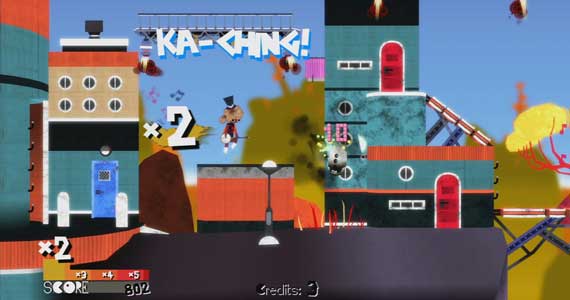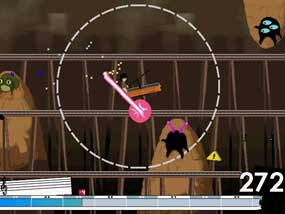
Pieces Interactive’s Fret Nice arrives on the PlayStation Network tomorrow, with an XBLA date still to be announced. The guitar controlled platformer has had a long road toward a console release, during which time the game’s unique visual aesthetic has evolved quite a bit.
Remembering the game’s first appearance in 2007, I was hoping to find out more about how exactly this evolution took shape during the development process, and to my infinite delight Fret Nice’s Creator/Designer Mårten Brüggemann offered an extremely insightful and detailed response that follows the game from its origins through to the final release available tomorrow.
Catch it all in Mårten’s own words, after the break.
Fret Nice Creator/Designer Mårten Brüggemann –
“The game actually started as a degree thesis project, and as that aimed at looking into the concept of adding an unorthodox game controller into an ordinary game genre, such as the 2D platformer to see what benefits could be drawn from the new way of controlling the game. Although the game has since evolved to being not so much about the academic side of things, the guitar controller and what it can be used for in its new context has always been the essence of Fret Nice’s design.
“One important point while designing the game around the guitar controller was to never lose the feeling of actually using a guitar for controlling the game and that it, in this case, would be the ideal choice of controller. We in fact wanted the game to be played like a rock song, and from that the attack system of the game, The Riff Combos, are derived. The Riff Combos focus on a part of music playing that is usually non-existent in existing music games.
“The games that are normally played with the guitar controller or dance mat games have their focus on rhythm based interaction. In Fret Nice we wanted to add the improvisation part of music, and the Riff Combos combined are a perfect way to explore this. Fret not, no need for any musical experience as the magic Riff Combos will always play in tonality with the background tracks.
“From the first prototype version of the game, completed in 2007 and awarded with a grand prize at the Swedish Game Awards, the game has evolved quite a bit.
“Both game design and art direction has been given an overhaul to better suit the medium it now is released for.
“Gameplay-wise we learned a lot from the first Fret Nice. This version of the game was heavily based around the first generation of guitar controllers. This meant that a lot of the action in the game was slowed down to accommodate the clunky mechanics of those controllers. The final console version of Fret Nice has been sped up a lot to feel more like players are used to with the platformer genre.
“With the console version of Fret Nice a goal was to make the game playable with a normal gamepad as well, to include players that don’t own guitar controllers, or just to make it easier for players to gather enough controllers to play cooperatively with a friend. When playing the game with a gamepad the player also expects the controls of a platformer to behave a specific way, and this also led to some tweaks in how the game was played with a guitar.
“Both controller types have their advantages over the other, the guitar being tailored for the music-based Riff Combos and the conventional gamepad stemming from the conventions of the platformer, but none of them should totally outdo the other.
“The graphical side of Fret Nice is perhaps what has changed the most.
“The first version of Fret Nice was created in a semi-retro pixeled style. This style was actually a result of the restrictions of the developing environment that was chosen for this version.
“When we started thinking about making something more of the game than just the 3 level demo, we felt both the style and the developing environment was holding us back.
“Thus we started looking into ways to bring the game into 3D, both to make it feel more next-gen, but also because we deemed it would be impossible to keep the style out of efficiency reasons.
“The first new iteration of the graphical style of Fret Nice we did was more or less a direct conversion of the 2D world into 3D.
“Out of an efficiency perspective this would have been hard to realize to its full content (and also I think our graphical artists were growing a bit tired of the old world).
“So the next concepting step was to make a much simpler style. This would be the start of the new look for Fret Nice.
“We felt this style was a step up from the older versions, and we felt it was a bit more unique as well. We started building upon this style, exploring other settings and more defined guidelines for how this new world would work. And eventually we did a small prototype in this style.
“At this point Pieces were in discussions with Tecmo and it was from this newer prototype version we started out working with the final version of Fret Nice.”







Too bad all my music-like instruments are for Wii since it would have been nice to get this on thursday…
Comment by EdEN — February 3, 2010 @ 4:58 pm
Awesome to get this kind of insight into a design process. All studios should be more open about these things.
Comment by reallyjoel — February 4, 2010 @ 1:58 pm